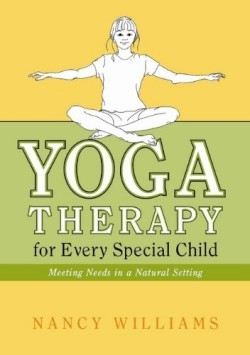Yoga Therapy for Every Special Child
Meeting Needs in a Natural Setting
All yoga is therapeutic, or so believe yogis and their teachers. However, yoga therapy, a new branch of yoga practice is gaining greater acceptance. Yoga therapy combines techniques like breathwork, meditation, and yoga postures to address specific issues or boost overall wellness.
An experienced yoga therapist with a focus on children’s needs, author Nancy Williams notes that yoga can be particularly helpful for children with special needs like autism, developmental disorders, ADHD, emotional sensitivity, and even cancer. With clarity and insight, she espouses yoga’s benefits, including body awareness, sensory integration, and better sleep. Her proposed program has several components that include traditional postures, as well as various breathing exercises and guided imagery.
Although this work will be valuable for yoga therapists and yoga teachers who want to expand their teaching skills, the accessible writing and many illustrations make it an ideal book for parents, school teachers, and therapy professionals as well. Even if there’s skepticism about some aspects of yoga-such as how the energy centers, or “chakras,” affect the body-Williams articulates each pose’s benefits in a way that synchs with Western thought.
For example, she describes one of the most common postures in yoga, child’s pose, in which a person sits back on the feet and brings his or her forehead to the mat, basically curling into a ball. The benefit of the pose, writes Williams, is that it “facilitates foot and ankle extension, with the weight of the body resting on the legs. Complete flexion of the body is established, and a folding of the skeletal frame. Neck elongation is accomplished through proper head placement.”
Particularly valuable are the modifications she includes for each pose, which address potential physical limitations. She encourages the use of yoga props, like blankets, to help children get into a pose safely and reap its benefits without exacerbating any physical challenges.
The poses, breath exercises, and guided meditation presented here should be invaluable not just for special needs children, but for all children. In the current culture of overscheduling and underexercising, Williams’ simple postures can be advantageous for relaxation and coordination.
As Williams’ work is used beyond her own yoga therapy practice, it’s likely that the book will fulfill her vision: “I hope to see transformations that will allow each child to blossom into their highest potential by improving skills in all areas of development, while amplifying the quality of their lives.” (January) Elizabeth Millard
Disclosure: This article is not an endorsement, but a review. The publisher of this book provided free copies of the book to have their book reviewed by a professional reviewer. No fee was paid by the publisher for this review. Foreword Reviews only recommends books that we love. Foreword Magazine, Inc. is disclosing this in accordance with the Federal Trade Commission’s 16 CFR, Part 255.

